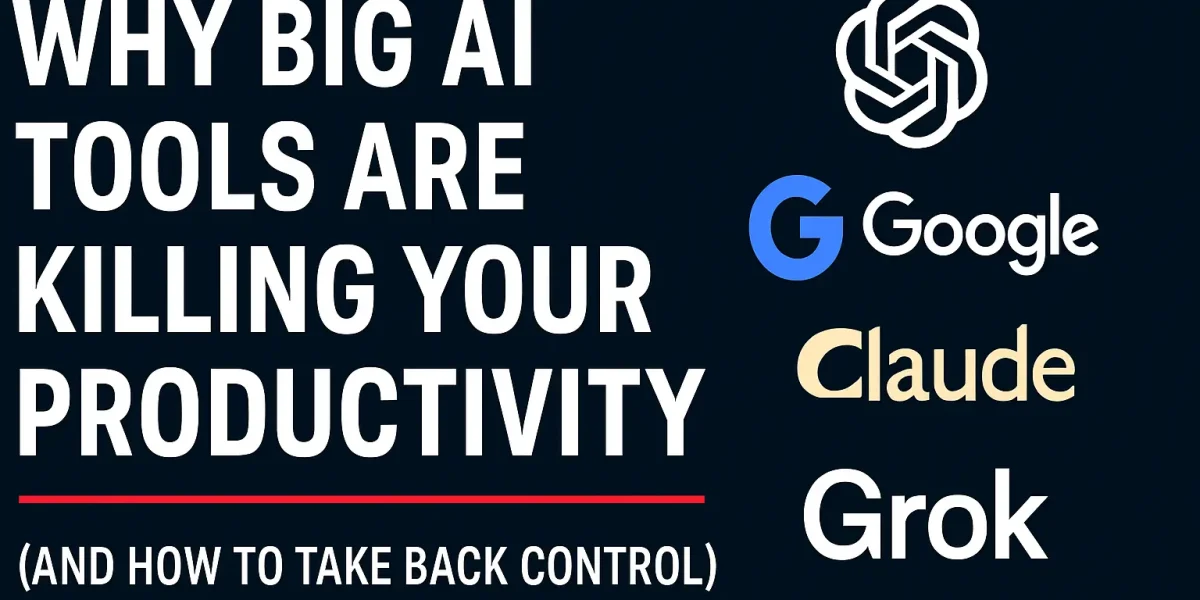
Why Big AI Players Are Quietly Killing Your Productivity — and How to Fight Back
👋 Hey there, fellow builders, dreamers, and code warriors.
I’m writing this not from an ivory tower, but from the trenches — where decision fatigue is real and shiny AI toys are everywhere.
Let’s be honest for a second.
We thought AI would boost our productivity, right?
Instead, most days it feels like we’re stuck in an endless loop of:
Trying ChatGPT
Switching to Gemini
Flirting with Claude
Wondering if Grok even knows what day it is
… and by the time we pick a tool, the task itself feels three lifetimes old.
I get it because I live it. As an AI researcher and full-stack developer who’s signed up for literally every pro plan, I can tell you: Having access to too many AIs can wreck your workflow if you don’t have a selection system.
Big players aren’t slowing us down because they suck — they slow us down because they’re all good at different things. And nobody taught us how to pick the right hammer for the right nail.
And that’s where the real game begins.
🚨 The Silent Crisis: Decision Paralysis at Scale
Here’s the dark truth nobody puts on those LinkedIn motivational posts:
When everything is possible, nothing feels clear.
Switching between 5 AI tools for one task isn’t “exploring options.”
It’s operational chaos.
A few hours spent tool-hopping feels like progress.
But it’s an illusion.
You’re burning mental fuel on decisions, not outcomes.
Imagine trying to run a marathon while stopping every 100 meters to change shoes. That’s exactly what many tech pros are doing right now.
🧠 Why the New Big AI Players Fragment Your Efficiency (2025 Edition)
Let’s call it out like it really is:
| AI Player | Secret Superpower | Where It Sucks |
|---|---|---|
| ChatGPT (GPT-4o) | Generalist brilliance + complex reasoning | Slightly verbose, not ultra-speedy in research |
| Google Gemini 2.5 Pro | Research speed + citation-backed search fusion | Can hallucinate when overtrusted without checks |
| Claude 3.7 | Deep philosophical thinking + emotional intelligence | Slower at strict math, not built for coding-heavy tasks |
| Grok 3 (X.ai) | Humor + pop culture radar + real-time trend awareness | Immature for deep technical or academic tasks |
| DeepSeek R1 | Precision problem-solving + hardcore search logic | Can feel rigid; less creative on open-ended tasks |
| Meta LLaMA 4 | Ultra-factual + stripped-down, minimalist reasoning | No emotional intelligence; mechanical if prompt is vague |
⚡ The Real Problem: We Aren’t Trained to Choose (2025 Reality Check)
Nobody handed us a playbook like:
Use Gemini 2.5 Pro → when you need fast, research-driven data, citation-rich insights, or detailed reports across multiple viewpoints.
Use ChatGPT-4o → when you need deep logical reasoning, strategic thinking, or layered business frameworks.
Use Claude 3.7 → when you’re writing long essays, reflective pieces, sensitive content, or need emotional depth and layered analysis.
Use Grok 3 → when you want humor, viral pop culture takes, fast real-time commentary, or punchy casual content.
Use DeepSeek R1 → when you need precision-based problem solving, hardcore search logic, algorithmic analysis, or accurate tech/computing answers.
Use Meta LLaMA 4 → when you want ultra-straightforward, factual outputs, minimalist reasoning, or instruction-based answers without fluff.
Without this system?
We’re just vibing.
And vibing doesn’t scale.
Execution does.
🛠️ How I Solved It: The “AI First-Rescue Framework” (2025 Version)
After getting punched by time-wasting loops one too many times,
I built my own mental checklist.
It’s simple. It works.
You can steal it.
Step 1:
Before opening any AI app, ask yourself one hardcore question:
“Do I need facts, logic, empathy, humor, precision, or stripped-down factual answers?”
Step 2:
Match the need to the right tool:
| Need | Best AI to Open |
|---|---|
| Facts, Research & Current Events | Gemini 2.5 Pro |
| Logical Strategy, Business Planning & Code | ChatGPT-4o |
| Empathetic Writing, Essays, Reflections | Claude 3.7 |
| Humor, Pop Culture, Viral Vibes | Grok 3 |
| Precision-Based Problem Solving & Technical Search | DeepSeek R1 |
| Straightforward, Factual, No-Fluff Outputs | Meta LLaMA 4 |
Step 3:
Set a timer.
Maximum 15 minutes per tool-switch experiment.
No endless wandering, no chasing dopamine.
Step 4:
Write a “Tool Memory” doc.
Every time you learn what a tool excels at, note it down.
Over 10 days, you’ll become a surgeon, not a wandering explorer.
🚀 Future-Ready Mindset: Be a Tech Curator, Not a Collector
The game isn’t about knowing more tools.
It’s about mastering a few.
Skeptical hot take:
In 5 years, companies won’t care if you’ve used 20 AI platforms.
They’ll hire the person who knows when and why to deploy the right one — faster and sharper than anyone else.
Become that person.
✨ Real-World Example: How I Cut My Workflow Time by 50%
Last month, while working on a fintech AI chatbot project, I made this decision matrix:
Gemini 1.5 for real-world financial data
ChatGPT 4o for API integrations and backend logic
Claude for writing UX microcopy (those friendly chatbot tones)
Result?
Task finished in 4.5 days instead of 9.
Brain? Clear.
Client? Happy.
Me? Legendary.
🔥 Final Thoughts: Your Future Self Will Thank You
AI isn’t slowing us down.
Bad choices are.
You’re already powerful — having Gemini, ChatGPT, Claude, Grok at your fingertips is like having the Avengers on speed dial.
But you need to be the Nick Fury.
You need to orchestrate.
And honestly?
That’s what will separate winners from wanderers in the AI economy that’s coming hard and fast.
Stay sharp. Stay tactical. Trust your process, not your curiosity rabbit holes.
👋 See you at the top, legend.
About the Author:
Jitendra is an AI Researcher and Full Stack Developer, passionate about blending innovation with productivity. When he’s not building next-gen AI systems, he’s helping tech professionals master decision-making frameworks that future-proof their careers.
→ Follow Jitendra on LinkedIn
